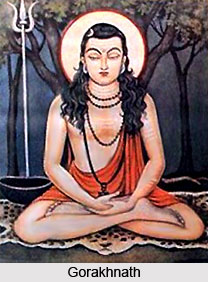 Among the Nath Siddhas, Nath Siddha Gorakhnath or the Lord of the Dung is probably one of the most famous. The Indian subcontinent is rich with stories and miraculous anecdotes about the life of the great saint Gorakhnath. Nath Siddha Gorakhnath was born in the Punjab around the tenth century, although legend often dates his birth to a far more remote past.
Among the Nath Siddhas, Nath Siddha Gorakhnath or the Lord of the Dung is probably one of the most famous. The Indian subcontinent is rich with stories and miraculous anecdotes about the life of the great saint Gorakhnath. Nath Siddha Gorakhnath was born in the Punjab around the tenth century, although legend often dates his birth to a far more remote past.
Nath Siddha Gorakhnath traveled extensively across India, from Sindh to Bengal and from Nepal to Sri Lanka. In Nepal, this Nath Siddha Guru is said to have caused a twelve-year drought by the power of his meditation, which was only ended by the mediation of Nath Siddha Matsyendranath. The city of Gorka in Nepal is named after Gorakhnath and its descendants now form the tribe of the Gurkas. Nath Siddha Gorakhnath is believed by his followers to be immortal and living to this day in the Himalayas. However, the vast temple complex in Gorakhput in Uttar Pradesh is a tomb that encloses his body that was absorbed in Samadhi. His Hindu name Goraksha is probably derived from "Protector of the Cows (Go)," or from a legend in which a woman, wishing to bear a son, received some ashes from Shiva`s fire and instead of swallowing the ashes she threw them on a pile of dung or ghor and twelve years later Nath Siddha Matsyendranath recovered a boy from this dung pile, whom Shiva named after Gorakhnath or the "Lord of Dung".
Nath Siddha Gorakhnath is said to have inspired great luminaries like Kabir, Gopi chand, Guga, Puran Bhagat and Guru Nanak or the founder of the Sikh religion. In one record, Nath Siddha Gorakhnath is even reputed to have been the foster father and the teacher of the Prophet Muhammed. The followers of Nath Siddha Gorakhnath are known as Gorakhnaths. Along with the Gorakhnaths, the Naths and Kanphatas form the largest Indian tantric tradition.
The Kanphatas are named after the traditional practice of splitting the centre of the ear to accommodate large ear-rings, usually made from rhinoceros horn, ivory made of conch, copper or gold. Great importance is attached to these earrings and if they are pulled out or the ear and mutilated the Kanphata yogin becomes an outcaste. In certain parts of India such a Kanphata yogin would be buried alive with no tomb erected over his body.
This article is a stub. You can enrich by adding more information to it. Send your Write Up to content@indianetzone.com




















